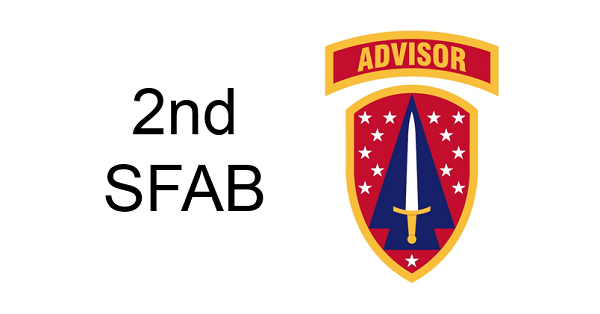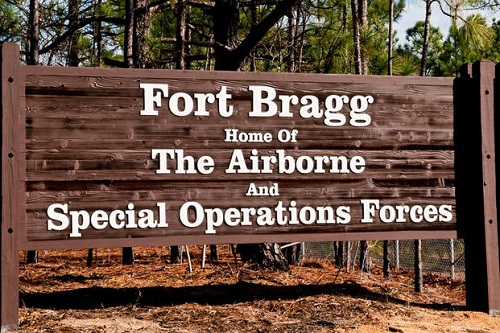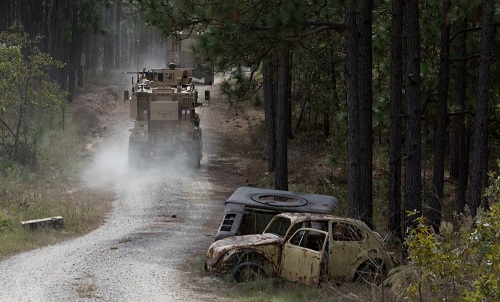
The 2nd SFAB or Security Force Assistance Brigade is scheduled to deploy to Afghanistan in early 2019. The unit was formed up in early 2018 at Fort Bragg, North Carolina. It has been moving into its new compound, receiving personnel and equipment, and conducting training for its advisory mission in Afghanistan. The 1st Security Force Assistance Brigade returned from its nine month long mission in November 2018.
SFAB Concept
The formation of the SFABs is based on the recognition of the need to have a permanent, professional advisor force – in addition to that of U.S. Army Special Forces. Under General Milley’s guidance the professional advisor corps concept has finally come to fruition. General Milley and others have come to the conclusion that the U.S. is likely to be involved in train, advise, and assist operations for some time in the future. The SFABs are a very high priority for the Army. The Army plans to have a Security Force Assistance Command (SFAC) and six SFABs up and running by 2022.

2nd SFAB Start Up
In December 2017 the U.S. Army announced that it would begin the formation of the second of six Security Force Assistance Brigades at Fort Bragg, North Carolina. The decision to base the new unit at FBNC included the projected time to activate and train the 2nd SFAB, the presence of senior grade personnel to man the unit, and the capability of FBNC to provide the facilities and training resources needed to base the unit. Fort Bragg is one of the largest military installations of the U.S. Army.
Organization
Although based on the brigade combat team (BCT) model the unit has only 800 personnel. There will be a headquarters unit and several battalions – each battalion providing combat advisor teams. The advisor teams are small – usually 12 members per team. In addition, additional personnel may be assigned or attached to the team to provide force protection.
Personnel
The 2nd SFAB commander is Brigadier General Donn Hill. He was most recently the XVIII Airborne Corps’ G/3/5/7 at Fort Bragg, NC. CSM Ken Killingsworth is the 2nd SFAB Command Sergeant Major.
Many of the unit members arrived over the summer of 2018, reassigned from other Army units from Fort Bragg and from around the country. Most of the personnel are senior and noncommissioned officers. The ideal SFAB Soldier already has expertise and experience in training and advising foreign military forces. The unit commanders and leaders in the 2nd SFAB will have already commanded similar units at the same echelon. So the officers and senior NCOs should be very experienced in their positions.
For instance, one of the 2nd SFAB battalion commanders is LTC Johnny Casiano. He is the former commander of the 1st Battalion, 77th Armor Regiment, 3rd Brigade, 1st Armor Division at Fort Bliss, Texas. The Senior Enlisted Leader is CSM Craig Jeffrey who formerly was with Fort Bliss’s 3-41 Infantry, 1st Brigade, 1st Armor Division. [1]
There are over 70 different military occupational specialties (MOSs) required to fill an SFAB. These MOSs include infantry, medics, intell analysts, logistics, and more. Not all personnel will be advisors. All personnel in the SFAB need to be able to deploy.

2nd SFAB Soldiers training at Fort Benning, March 10, 2018.
Advisor Training
The personnel who will perform advisor duties within 2nd SFAB have or will attend the Combat Advisor Training Course at the Military Advisor Training Academy (MATA), Fort Benning, Georgia. Although the MATA is ‘advertised’ as a six-week long advisor training course the training being conducted is abbreviated at this time.
The subjects covered in the Combat Advisor Training Course at Fort Benning include instruction in map reading, land navigation, medical training, personnel recovery, culture, advisor assessment, training development, antiterrorism, and force protection. [2]
The length of training for most 1st SFAB Soldiers at the MATA was two weeks. For most 2nd SFAB Soldiers the MATA course is reported to be four weeks long. In addition, the future advisors will receive home-station training at FBNC as well as further advisor training at JRTC. Many of the officers and NCOs already have advisor experience in either Afghanistan or Iraq.

(Photo by Spc. Andrew McNeil, 22nd Mobile Public Affairs
Detachment, U.S. Army, October 24, 2018.)
2nd SFAB Training at FBNC
The personnel in an SFAB have or will be screened for their qualifications and experience. [3] Once accepted into the SFAB some of the Soldiers – depending on their role in the unit – will attend the Military Advisor Training Academy. In addition, many will attend specialized training – language, foreign weapons, and the Joint Fires Observer course. In addition to the ‘battlefield survival’ training and traditional unit pre-deployment training, members of the 2nd SFAB will undergo training in language, culture, negotiation and mediation. There are a number of different job specialties on a combat advisor team – and there is a fair amount of cross-training that takes place at team level. Typical cross-training would include medical skills, communications, call for fire, vehicle maintenance, and more. The 2nd SFAB is being assisted in training for the Afghan deployment by members of the 1st SFAB who have recently returned from their Afghan deployment.
In October the 2nd SFAB held training events at Fort Bragg. This training went beyond the individual and specialized training Soldiers had been taken part in since the summer months. Training events included mounted and dismounted patrolling, medevacs, calls for fire, and security operations. The October training was part of the process to prepare for the brigade’s validation at JRTC.

An instructor provides cultural training to members of the
2nd SFAB attending the Security Force Assistance Course at Fort Polk.
(Photo by Chuck Cannon, December 6, 2018).
Security Force Assistance Course
In December the 2nd SFAB leadership team attended a week-long class on security force assistance in Afghanistan. The personnel of Alpha Company, 3rd Battalion, 353rd Infantry Regiment at the Joint Readiness Training Operations Group at Fort Polk, LA provided the theater-specific training.
Alpha company maintains a liaison officer (LNO) in Afghanistan to provide feedback to the Security Force Assistance course instructors on specific questions and important events taking place in Afghanistan. The JRTC unit will also send 10 linguists with the 2nd SFAB when the brigade deploys to Afghanistan. The goal of the SFA course is to get 2nd SFAB senior officers and NCOs more familiar with the future advisory role in Afghanistan.
JRTC Rotation
In January 2019 the 2nd SFAB will attend a Joint Readiness Training Center rotation at Fort Polk, La. JRTC doesn’t certify individual SFAB Soldiers as advisors, that is done at the MATA. But those Soldiers who did not attend the MATA will receive some advisor training. The JRTC rotation will certify the unit for its Afghan deployment.
Deployment to Afghanistan
The 2nd SFAB is scheduled to deploy to Afghanistan where it will field more than 30 combat advisor teams. [4] The teams will likely be dispersed throughout the country – most likely serving at the corps and brigade level (Afghan units) as advisors and trainers. Some teams may serve at the kandak (battalion) level.
(Editorial Note: Since this article was published President Trump has looked at the possibility of reducing the U.S. military presence in Afghanistan by 7,000 troops. This could have an impact on the 2nd SFAB deployment).
No Overlap with 1st SFAB
One aspect of the 2nd SFAB deployment to Afghanistan is that there is no overlap of the SFABs in theater. Usually when one unit replaces another there is a ‘left seat right seat’ transition on a unit and individual basis. Typically the arriving unit would phase in its personnel and equipment over a two-week period while the departing unit would start sending its personnel and equipment home. From an advisor standpoint this is a critical event. An advisor who has worked with his Afghan counterpart would have an opportunity to brief up his replacement and then introduce his replacement to his Afghan counterpart – an important transition.
Unfortunately, the 1st SFAB completed its Afghan deployment in November, and there will be no in-country transition with 2nd SFAB. With several months in between the SFAB deployments this is a less than optimum circumstance. It was probably considered an acceptable risk to have a gap in the two SFABs during quieter winter months when insurgent activity is not at its peak.
This lack of overlap is being compensated by four actions. One is that there has been a steady flow of information from the 1st SFAB to the 2nd SFAB – sharing lessons learned – during 1st SFABs deployment and continuing to the present now that the 1st SFAB is back at Fort Benning. A second is that selected members of the 1st SFAB are attending / observing 2nd SFAB training, at Fort Bragg, during the SFA course held at Fort Polk in December, and during the January JRTC training rotation. A third is that some members of the 2nd SFAB may deploy earlier than usual – something that units rotating in and out of Afghanistan should have been doing for years . . . but didn’t. A fourth is that selected members of the 1st SFAB – possibly as many as 100 – will accompany the 2nd SFAB into Afghanistan for the first few initial weeks to assist with the transition and to conduct ‘first engagement’ meetings with the Afghan counterparts. [5] Someone did some solid thinking to come up with this fix.
Lessons Learned
The 1st SFAB has passed on some lessons learned (LL) to the 2nd SFAB. Many of the lessons brought back by 1st SFAB “. . . pertain to getting out and doing patrolling again with Afghan partners instead of just staying at FOBs (forward operating bases).” [6] Other LL include the insider threat facing advisors and the importance of feeding “bottom up” feedback to coalition partners and the higher echelons of the ANDSF.
Logistical Support in-Country
Providing support to a unit that will disperse its elements across Afghanistan is problematic. The 2nd SFAB will be spread out among the many different Train, Advise, and Assist Commands (TAACs) and Task Forces. In addition, the small teams will need to be supported by host units and will require access to logistical and equipment support that larger units normally have available within their organic capabilities. There are some ‘lessons learned’ from the recent deployment of the 1st SFAB to Afghanistan – one of which is that SFABs need more logistics support than anticipated. The “. . . SFABs need a more robust logistics structure, . . .” [9]

An advisor and interpretor conduct an interview with a ‘local national’ under
the watchful eye of a Guardian Angel during training for the Wisconsin National
Guard’s 2nd Battalion, 127th Infantry Regiment at Camp McCoy, Wisconsin in
October. The 2-127th was preparing for its role as security force for the 2nd
Security Force Assistance Brigade’s deployment to Afghanistan in 2019.
(Photo by Chuck Cannon, JRTC, November 2, 2018.)
Guardian Angels
The insider attacks that took place in the summer and fall of 2012 almost derailed the ISAF mission in Afghanistan. This period was the height of the ‘green-on-blue’ threat with numerous incidents of US and NATO troops being killed by Afghan security force members. A number of measures were instituted to mitigate the insider threat in late 2012 and the years following. One force protection measure that seems to have helped diminish the insider threat is the use of ‘Guardian Angels’. These personnel are selected and trained to protect advisors working with the ANDSF. So while the advisor is traveling to, from, or conducting training or attending meetings with the ANDSF the Guardian Angels are looking out for the advisor’s safety. This allows the advisor to concentrate on his primary task of advising, training, assisting, and enabling his ANDSF counterpart and unit.
Usually the Guardian Angels are formed from within the advisory unit. However, the 2nd SFAB will be working with a Wisconsin Army National Guard unit for its force protection. About 400 Soldiers from 2nd Battalion, 127th Infantry are assigned this task. This is the first time the unit will be deployed to Afghanistan. [7] The unit has had deployments to Iraq in 2005-06 and 2009-10. The personnel of the 127th recently received training from the Joint Readiness Training Center based at Fort Polk, La. The unit members will also attend the January 2019 JRTC rotation at Fort Polk with the 2nd SFAB. [8]
Conclusion
Based on reading open source material available in the media, news releases by the U.S. Army, social media platforms, and other sources it appears that the establishment and training of the 2nd Security Force Assistance Brigade is on track. The unit should be ready for its deployment to Afghanistan and it will very likely have a successful deployment. Hopefully, the 2nd SFAB will perform as well or better than the 1st SFAB and will further validate the SFAB concept of permanent, professional advisor units. In addition, there is the opportunity to further develop the capabilities and effectiveness of the Afghan National Defense and Security Forces during the 2nd SFAB deployment.
Footnotes
[1] See “Bliss’ Casiano will help to train, develop militaries with partner nations”, El Paso Times, January 13, 2018.
[2] For more on instruction offered at the MATA see “2nd SFAB Training as Combat Advisors at Fort Benning”, Benning News, March 2, 2018.
[3] For more on screening of SFAB personnel see “SFAB Selection for Security Assistance Brigade”, SOF News, November 4, 2017.
[4] The Afghan deployment of 2nd SFAB was announced in “Department of the Army announces upcoming 2nd Security Force Assistance Brigade unit rotation”, U.S. Army Public Affairs.
[5] See “In unusual move, Army trainers will leave Afghanistan, return months later to help next unit”, Stars and Stripes, October 25, 2018.
[6] For lessons learned from 1st SFAB see “A Co, 353rd Inf Reg preps 2nd SFAB leaders for deployment”, Fort Polk PAO – DVIDS, December 14, 2018.
[7] “Wisconsin Guard soldiers given send-off for Afghanistan”, WAOW.com, November 29, 2018.
[8] See “Fort Polk Soldiers train Wisconsin Guardian Angels”, Fort Polk Public Affairs Office (DVIDS), November 2, 2018.
[9] See “US Army’s second SFAB unlikely to deploy with added logistics support”, Janes.com, November 7, 2018.
References
Collection of news stories about the 2nd SFAB
by Afghan War News.
www.afghanwarnews.info/sfa/sfab/2nd-SFAB-news.htm
ATP 3-96.1, Security Force Assistance Brigade, May 2018.
Access at https://armypubs.army.mil/epubs/. . . .
2nd Security Force Assistance Brigade, FBNC.
www.bragg.army.mil/index.php/units-tenants/xviii-airborne-co/security-force-assistance-brigades
Fact Sheet, Security Force Assistance Brigade, February 17, 2017.
www.army.mil/standto/2017-02-17
Frequently Asked Questions on SFABs, FBNC, (FAQ PDF)
SFAB FAQ.
SFAB Recruiting – Careers & Jobs.
GoArmy.com
GAO Report on Advising. Security Force Assistance: U.S. Advising of Afghan National Army Has Expanded since 2015, and the U.S. Army Has Deployed a New Advising Unit, Government Accountability Office, December 19, 2018.
https://www.gao.gov/assets/700/696165.pdf
Army Security Force Assistance Brigades (SFABs), Congressional Research Service (CRS), October 24, 2018.
https://fas.org/sgp/crs/natsec/IF10675.pdf